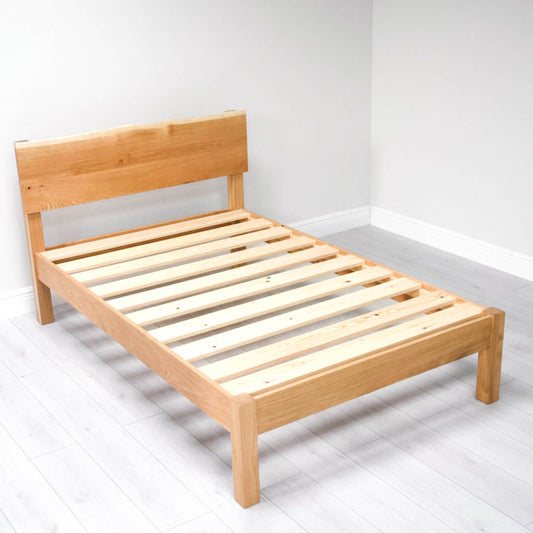Whether you’re a first-time or established homeowner, you’ll undoubtedly want to give your interior space the wow factor. More specifically, you might be keen to enhance the natural feel and character of your bedroom with quality wood furniture.
You may be tempted to go with veneer, as a safe and stylish alternative to solid wood. But what are wood veneers? Are wood veneers expensive? And is veneer a better choice than solid wood? Read on as we answer such key questions here.
What Are Wood Veneers?
In simple terms, wood veneers are thin layers of real wood (typically less than 1/40” thick), applied over cheaper materials to create the look of solid wood furniture. Veneers are commonly pressed or laminated onto inexpensive core substances, such as plywood and medium-density fibreboard (MDF).
Veneer can be made from completely natural hard or softwood. Alternatively, there’s a choice of reconstituted and engineered wood veneers. They’re commonly sourced from sustainable forests and have an exotic appeal.
Veneer vs Engineered Wood
Veneer and engineered wood aren’t the same. In the first instance, we’re talking about a thin layer of real wood typically applied as a surface finish. Engineered wood, meanwhile, is made through the bonding of wood fibres or thin layers to create boards or panels.
This is commonly used as the core material, with the strip of veneer layered over the top.
Veneer vs Solid Wood: Key Differences
Veneer varies from solid wood in terms of composition, thickness, and material quality. Such differences won’t always be immediately obvious, with manufacturers often trying to make veneer furniture look like solid wood. However, solid wood furniture stands apart with its separation of long and end grain, and the price tag is often a telling factor.
Where solid wood furniture is made using natural wood exclusively, veneer is made by attaching a thin strip of real wood to a core material. Solid wood furniture is also relatively heavy, with some variation in the patterning and feel of each piece.
The Appeal of Solid Wood
Solid wood furniture is robust, durable, and built to last. Repair and refinishing are also fairly simple, since you can easily sand out scratches and dents. While the quality of such furniture is often reflected in the price, you could see it as a long-term investment. Solid wood pieces typically retain their value, and get passed down as heirlooms.
Benefits of solid wood beds include:
- Aesthetic appeal - The natural beauty of a solid wood frame will be a stand-out in any room, adding a sense of warmth and craftsmanship.
- Sturdiness – Since they’re much stronger than the veneer alternative, you can rely on solid wood beds to support heavy mattresses and sleepers.
- Customisation - Solid wooden beds are available in a wide range of designs, finishes, and colours, so there’s bound to be one that matches your tastes.
Wood Veneer Benefits and Drawbacks
Of course, veneer furniture isn’t completely without merit. Given the attachment to fairly cheap core materials, it’s a more affordable choice. The flexibility of veneer means that it can be used for a great variety of surfaces, too. As mentioned, there’s a choice of veneers in exotic materials, with intricate and appealing patterns.
Solid wood furniture requires regular maintenance, with humidity changes increasing the risk of expansion and contraction. This isn’t the case with veneer, as core materials like plywood and MDF are relatively stable. However, repair can be a bit of a challenge, with the possible need for patching and attaching new pieces of veneer, since it can start to peel if kept in unsuitable conditions.
Veneer is considered the more eco-friendly choice, with a much greater yield than hardwood board or lumber. It also comes in a variety of stains and finishes to suit different tastes. However, there’s a greater risk of water damage without the regular application of sealant. Cracking is also fairly likely, given the different contraction and expansion rates of the veneer and core material. Of course, veneer also lacks the premium natural appeal of solid wood.
Quality Solid Wooden Beds
Recognising the drawbacks of veneer and not prepared to settle for second best, the Wooden Bed Company is committed to crafting quality solid wood beds. From our low wooden beds to our ottoman storage beds, we use solid wood materials such as Scandinavian pine and European oak across the range.
Each of our premium wooden beds is made with precision-machined mortise and tenon joinery for serious strength and reliability. Following a carefully developed 15-stage manufacturing process, we ensure the highest levels of satisfaction.
There’s no need to pay the earth for the premium quality of a solid wood bed when you buy directly from the manufacturer. And you can be confident in the longevity of your wooden frame with our full 12-year structural guarantee.
We take our environmental responsibilities seriously too, only using timber that’s sustainably sourced. With such a variety of benefits, there’s no denying that a solid wooden bed is the superior choice.















